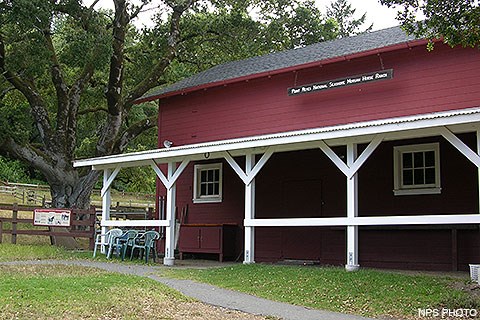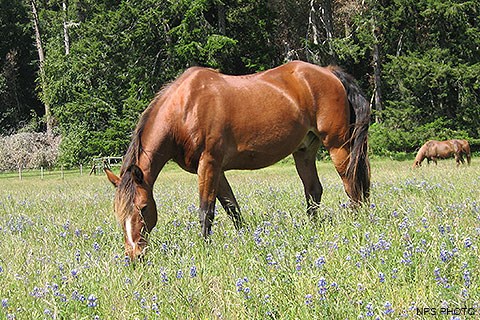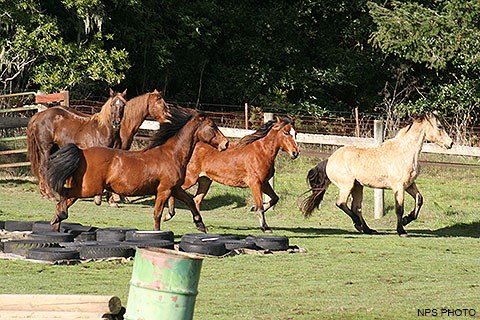

History of the Morgan Horse RanchThe Morgan Horse Ranch was established at Point Reyes National Seashore as an interpretative program as well as a breeding and training program to provide horses for the National Park Service. The ranch was dedicated in 1970 with the help of the Northern California Morgan Horse Association. Two mares were donated to the park and a select breeding program was set up with stud services provided by private owners. At its height, the ranch maintained a herd of approximately 35–40 horses, and bred 73 horses over the life of the breeding program. As foals were born, mature animals trained at the ranch were transferred to other parks. For many years classes were also held at the ranch to train park rangers in horsemanship. Currently, there is no need for a centralized breeding program because individual parks maintain their own stables. On July 8, 1999, the last filly was born at the ranch and was named Los Reyes Liberty Rose—Rose for short. Today (May 2023), there are five year-round resident Morgan horses at the ranch—Honcho, Mira, Knight Hawk, Gentry, and Moon. They are used as the Mounted Enforcement Team within the park and at special events. Park Rangers use the mounts for patrol deep into the backcountry and along the beaches so as to not disturb the natural beauty and wilderness aspects of Point Reyes National Seashore. Volunteers at the ranch are a vital component to proper care and maintenance of the Los Reyes herd. They can be seen at the ranch and on the trails providing essential training to maintain the horses. The horses are also used to assist with the tule elk census and the harbor seal counts. Visiting the Morgan Horse RanchThe Morgan Horse Ranch is open to the public seven days a week and there are usually horse ranch staff and/or volunteers present from 9 am to 4 pm. Interpretive exhibits in the ranch buildings and outside provide information about the history of the Morgan horse, the ranch, and how the horses were trained. The Morgan Horse Ranch is located on a small hill to the southwest of the Bear Valley Visitor Center. To visit, walk up the maintenance road located at the southeastern end of the Bear Valley Trailhead parking lot. AccessibilityWith a Disabled Person parking placard or plate, you may drive your vehicle along the maintenance road to a small parking area close to the stables. Exhibit areas are accessible. History of the Morgan HorseThe different accounts that have been circulated in regard to the origin of the Morgan breed of horses, agree that they are descended from a horse called Justin Morgan, who derived his name from Mr. Justin Morgan, of Randolph Vermont, once his owner. 
In 1795, Vermont choirmaster Justin Morgan was given a horse as payment for his musical services. Figure, as Justin named him, was a reddish-brown-colored bay stallion. He was short in stature, not much bigger than a pony. Morgan leased Figure to a local farmer as a workhorse to clear a woodlot. Much to the farmer's surprise, there was no log too large for Figure to pull. What he lacked in size, he more than compensated for in strength. Figure outpulled and outran all the other horses in the area. He was also known for his calm and steady temperament. After Figure died in 1821, his offspring who resembled him in size, form, character, and temperament became known as the Morgan horse breed. Morgan horses bear the distinction of being the only American breed of horse descending from a single parent of foundation sire. His proud, bold and fearless style of movement, his vigorous, untiring action, have perhaps, never been surpassed…. The quietness and exceedingly pleasant temper of the Justin Morgan, is strikingly evidenced…. 
Figure's descendants spread widely through the United States from their New England roots. As roads improved in the 1800s, there was an increasing demand for speedy, light harness horses such as the Morgan horse. Morgan horses played an important role during the American Civil war. They were bred and trained for use by the cavalry. The calm temperament of the horses makes them ideal to work in crowded and noisy situations. The National Park Service often uses Morgan horses for trail maintenance and patrol in rugged backcountry settings as well as urban patrols in cities such are New York and San Francisco. The Morgan is long in the side, but always short in the back, and strong and beautiful in the loins. His fine shoulder, too, differs…. It is well sloped, comparatively thin at the top, and heavy at the bottom, to give the horse the appearance of strength and endurance scarcely to be looked for in one of his spirit and fleetness. Volunteer at the Morgan Horse RanchThe Morgan Horse Ranch offers volunteers an opportunity to experience all aspects of horsemanship. They assist in ranch operations, including the care, handling and riding of horses of all ages, as well as the cleaning and maintenance of tack, equipment, fences, and buildings. Volunteers may also greet visitors, answer questions, and briefly explain their role as a volunteer. Experienced trainers are especially needed to help with the younger horses. The need for volunteers varies greatly throughout the year. more... Additional Reading:"Past and Present: The Point Reyes Morgan Horse Ranch," by Brenda L. Tippin, The Morgan Horse Magazine, April/May 2016. (3,561 KB PDF) |
Last updated: May 25, 2023
